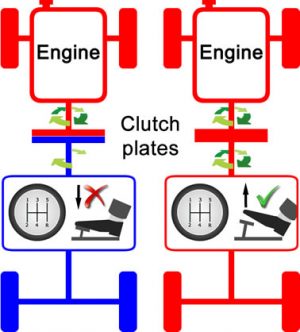To ride the clutch or riding the clutch meaning is technically the same as slipping the clutch, though slipping the clutch is intentional but riding the clutch isn’t.
Riding the clutch however differentiates from slipping the clutch because unlike slipping, riding the clutch causes unnecessary damage and wear to the clutch due to the driver of the vehicle being either unaware that they are riding the clutch or unaware that their actions are causing unnecessary wear.
Every driver of a manual vehicle must slip the clutch to move off or to move very slowly such as in very slow moving traffic or when performing a slow manoeuvre such as parallel parking for example. Slipping the clutch converts some of the engine power to be lost as friction.
This friction is generated by the clutch plate and flywheel slipping and allows the vehicle to be moved at a very slow speed. This process does however cause significant wear on the clutch. Although slipping the clutch is essential and unavoidable on certain occasions, riding the clutch is avoidable and will sooner rather than later require an expensive clutch replacement. Explained are some examples of riding the clutch and how to avoid.
Riding the clutch definition
Riding the clutch definition is that the clutch pedal must be somewhere between fully depressed (clutch plates disengaged) and fully released (clutch plates engaged). Fully engaged and disengaged clutch plates do not cause wear and is therefore not riding the clutch.
Driving for longer than normal distances with the clutch pedal fully depressed is known as coasting. Although not generally harmful to a vehicles components, it comes with its own potential dangers.
What is riding the clutch
Below provides some examples of riding the clutch.

-
Waiting in traffic queues
When you are waiting stationary in a traffic queue for example and the car in front is moving backwards and forwards ever-so-slightly. The driver of this vehicle is holding the car relatively stationary by riding the clutch. Although there are no dangers associated with riding the clutch providing it is done accurately, the driver is causing unnecessary wear on the clutch plates. If in a stationary position waiting in traffic, apply the handbrake and if stationary for long periods, select neutral.
-
Resting foot on clutch
Another common example of riding the clutch is driving whilst resting and keeping a foot on the clutch pedal. Whether actual riding the clutch (clutch slippage) takes place depends on how much pressure is exerted onto the pedal and how light the pedal mechanism is to press. If it is causing clutch slippage however, it is a rather expensive place to rest your foot as you will require a clutch replacement much sooner. If you are not using the clutch, simply remove your foot and rest it on the floor.
-
Moving the car off
Learner drivers are taught to find the clutch bite point whilst practicing clutch control. Finding the clutch bite point is a good method to help reduce stalling the car when moving off although it does significantly reduce the life of a clutch.
After a learner has gained confidence with their ability to control the clutch, they should be taught to keep the clutch fully depressed and release it slowly, hovering over the bite point area for a little longer before lifting. This is much kinder to the clutch, but unfortunately not all instructors teach this and stick with the riding the clutch method.
If you are in the habit of still using the bite point method, other than hill starts, there is no need. Practice moving the car off by releasing the clutch from the floor and holding the clutch in the bite point area just till the car gains momentum which is when it can be fully released.
Information related to the clutch
- Car clutch
- Slipping the clutch
- Clutch control
- Clutch bite point
- What is coasting
- How to stop stalling
- Wheelspin

I believe there should be more emphasis on clutch control when reversing and when parking the vehicle.